Old photos & postcards of Shelford Hall, Little Shelford
Shelford Hall was the family seat of the Wale family who were the principal landowners in Little Shelford for 300 years.
The first Shelford Hall, or the Old House, was built on land off Bridge Lane in 1660 by Thomas Wale. It was altered in 1764 by Thomas Wale and then partially demolished in 1852.
A new Gothic style house (pictured below), known at the time as the New Hall or Shelford House, was built by Col. Robert Gregory Wale about 100 metres north of the current Wale Recreation Ground in around 1850. It had six bedrooms. The servants' quarters were on the third floor.
To quote village historian, Graham Chinner, "Col Wale could hardly have chosen a less auspicious time to indulge in a palace.” The Corn Laws were repealed in 1845 meaning untaxed grain from America and Australia flooded the market and made the Shelford Farms owned by Col Wale difficult to rent. Col Wale finished up moving out of the Hall to Hall farmhouse around 1885. From then on, Shelford Hall seems to have been let to tenants. The first tenants were the Hallett family, who had struck it rich discovering gold in Australia until they lost most of their fortune in the Australian bank failures.
Extended members of the Wale family were also to become tenants later of the hall.
In the latter part of the 19th century, the hall seems to have been mothballed. Kellys Directory of Cambridgeshire for 1900 does not record it as occupied.
The hall burnt down in 1929. As the insurance covered only the value of the mortgage, rebuilding was not an option.
The owner at the time of the fire was Fanny Lucretia Wale, the compiler of the book “A Record of Shelford Parva”. She had not lived in the Hall for over 40 years, having let it to relatives for much of that time.
A fire, believed to have originated in the pantry, gutted the entire building. The roof caved in and there was little chance to retrieve any of the contents.
Press reports suggest that there were nine people in the hall at the time of the fire. None of them was injured.
Several outbuildings from the New Hall, including the former stables, have now been converted into two homes off Bridge Lane, Little Shelford.
The original gates to the New Hall can still be seen on Whittlesford Road, Little Shelford.
The Lodge to Shelford Hall still stands on the corner of Bridge Road and Whittlesford Road (it is the distinct yellow building). This building was the north wing of the original 17th century Old Hall. It was retained to be used as an entrance lodge to the new house.
There is a model of the original building in the possession of the Museum of Cambridge although it is not currently on display. (You can ask to see it.)
Click here to see photos of the New Hall
Click here to see photos after the fire at the New Hall
Click here to read about what life was like at Little Shelford New Hall.
Click here to see drawings and photos of the Old Hall
Click here to see drawings and photos of the model of Shelford Old hall - it is currently in the possession of the Museum of Cambridge but not on display.

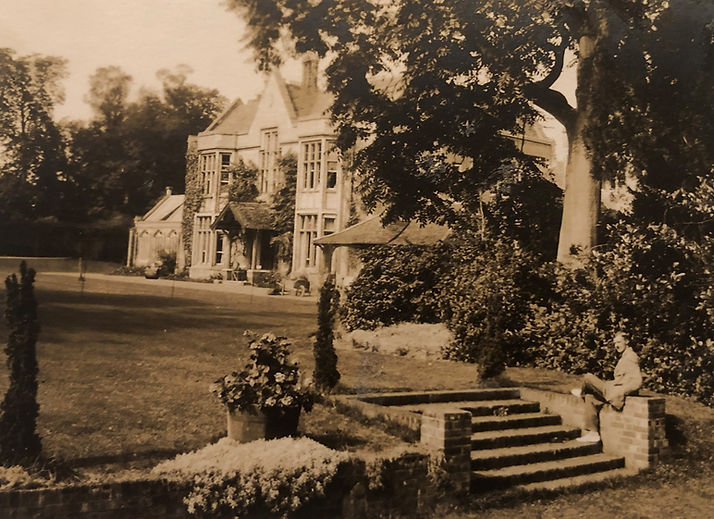
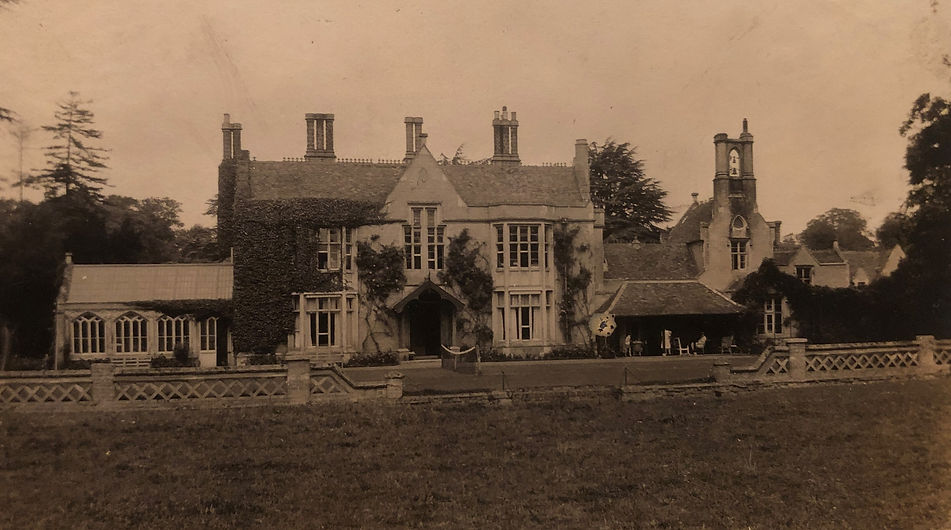

Freda (Wale?), Gracie (Wale?), Ned (Wale?), Auntie?, Midge (Wale?) and Isa Wale (later Eaden) on the ha-ha at Shelford Hall 1889
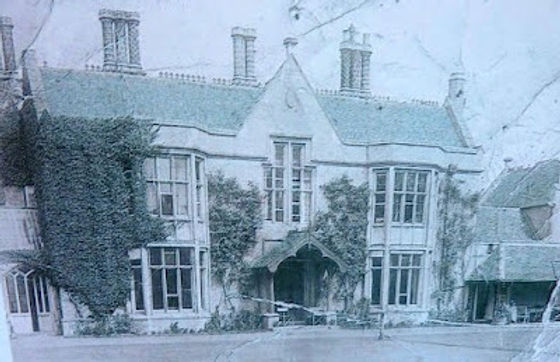
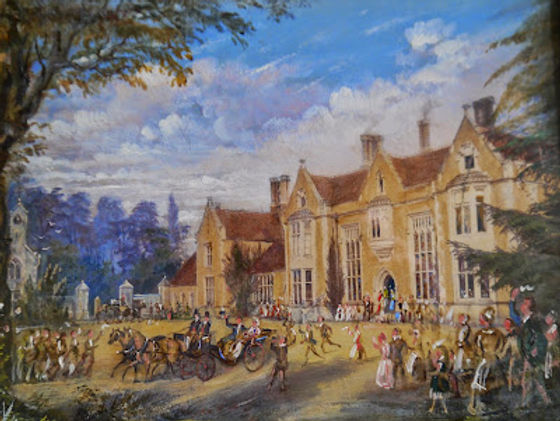
This is a painting of the society wedding of Adelaide Wale that took place at Little Shelford New Hall in 1881.
Memories of the day have been found in diaries written by Mrs Isabella Martha Willis.



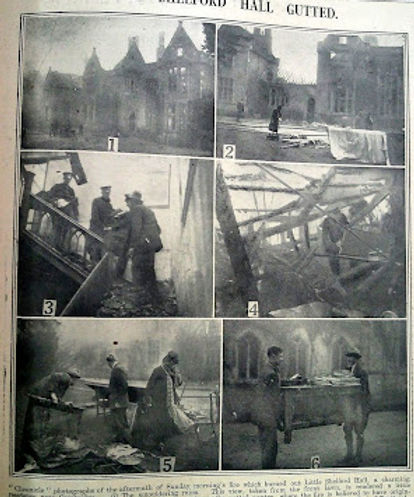


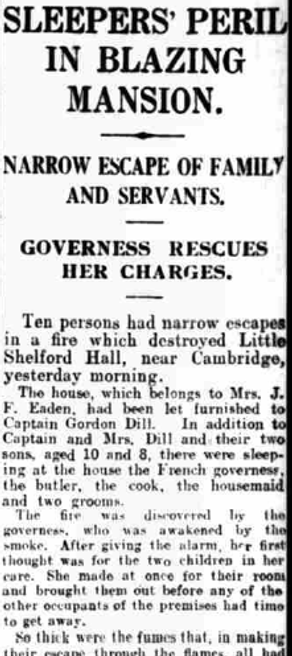
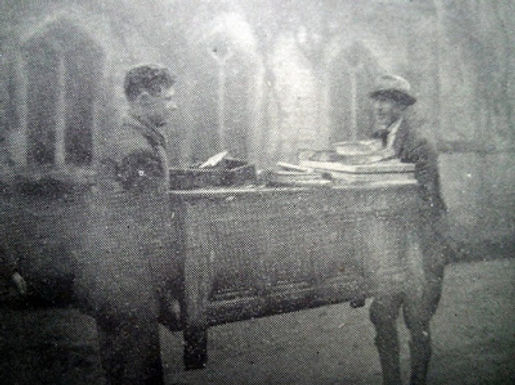


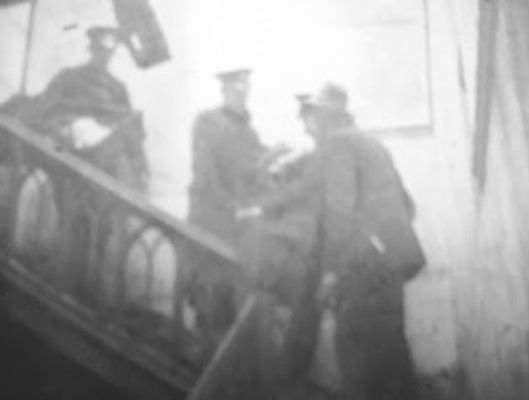
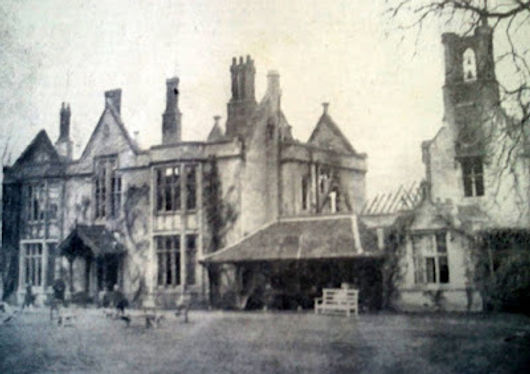


The back stairs of the hall after the fire

The top passage of the Hall after the fire


Isa and Jack Eaden, tenants of Shelford Hall at the time of the fire in 1929
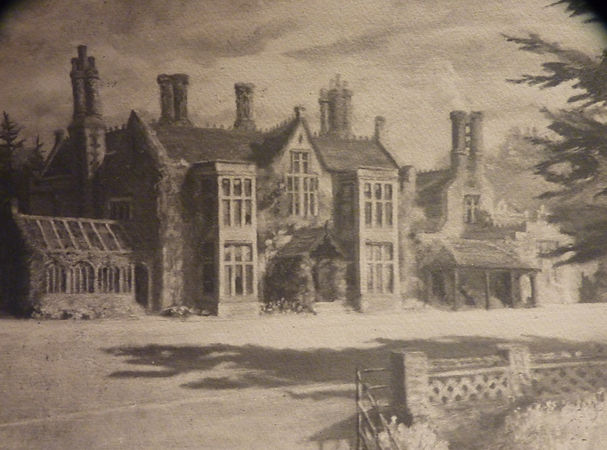
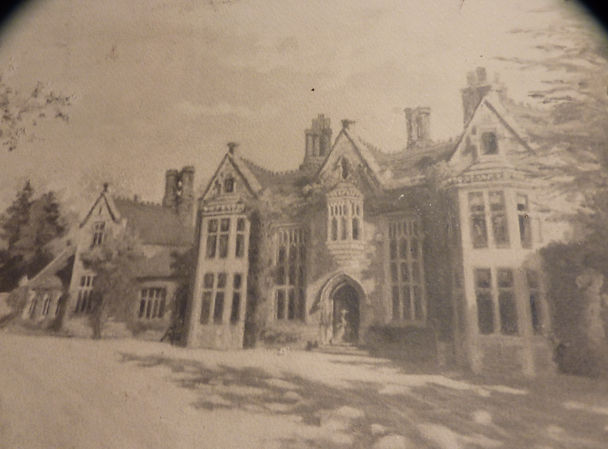

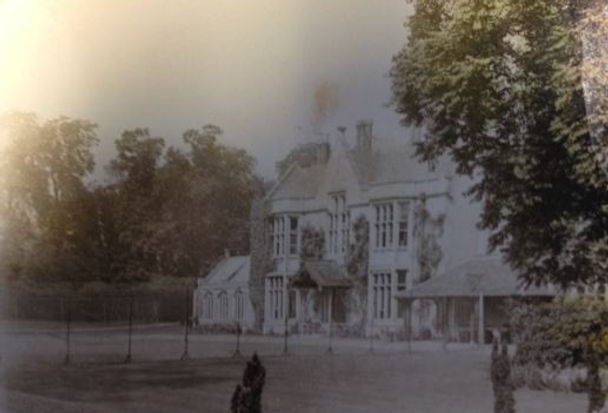

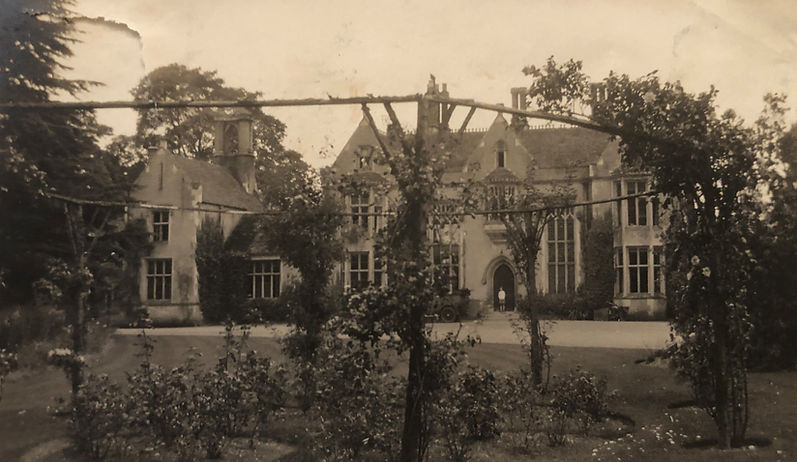
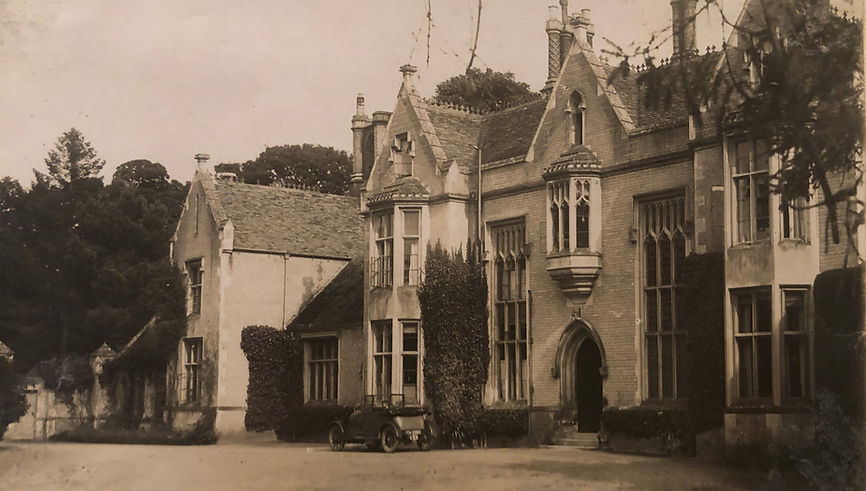


A painting of Shelford Hall by Fanny Wale in 1897 as it would be seen from Bridge Lane. The painting was unknown until it was put up for sale on Ebay in May 2020.
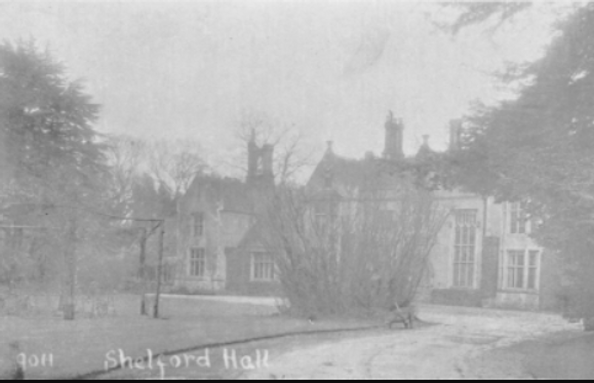
A postcard of Shelford New Hall from 1921 showing the driveway to the front (the west) of the house. The driveway entered the estate from Whittlesford Road.


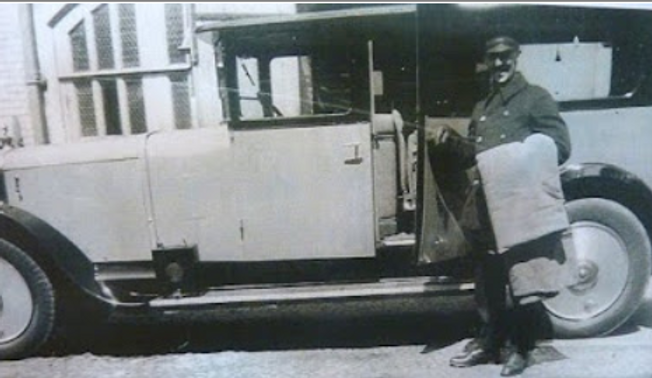
Hall chauffeur and gardener Albert Thorogood. He claimed he could drive to Marble Arch in 1.5 hours in the Daimler, which he later inherited.
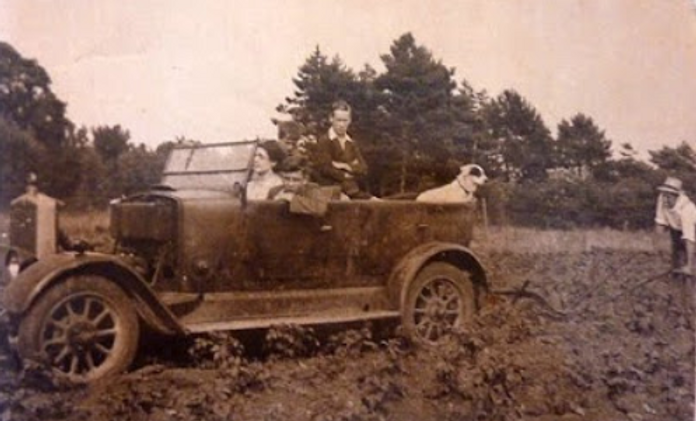
Hall chauffeur and gardener Albert Thorogood (far right). There are stories that he inherited the car but couldn't afford to run it. So he used it to pull his plough as seen in this photo. His family says he sold the Daimler he inherited and bought this car separately. He also attached a motor to the hall lawn mower creating the first mechanised lawnmower in Little Shelford.
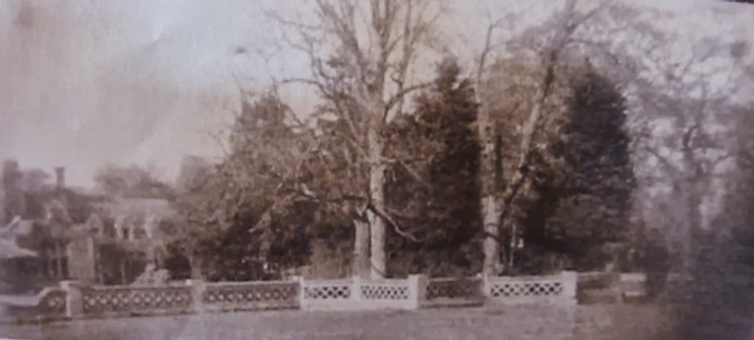
The southern aspect of Little Shelford New Hall from what is now the Wale Recreation Ground. Part of the ha-ha in the foreground still exists.
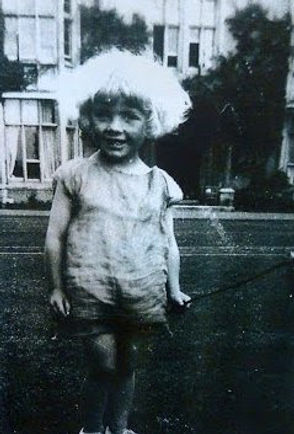
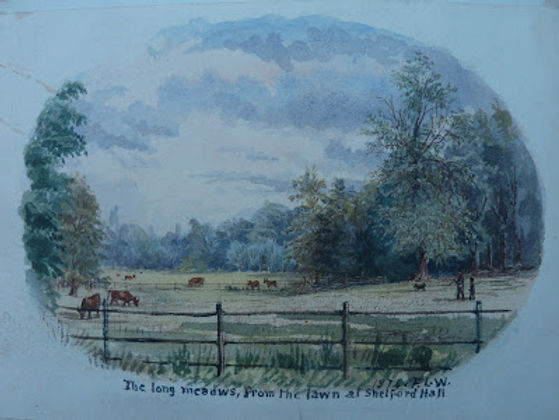
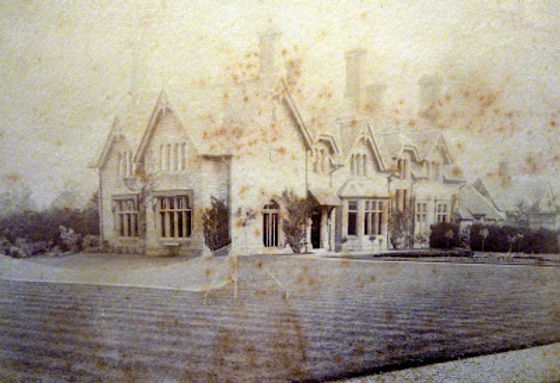
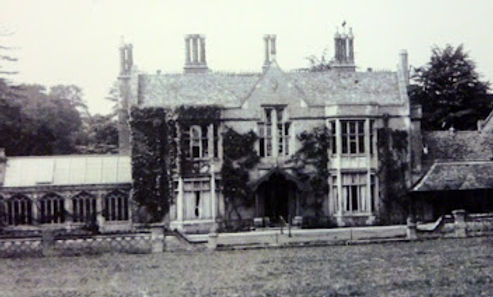

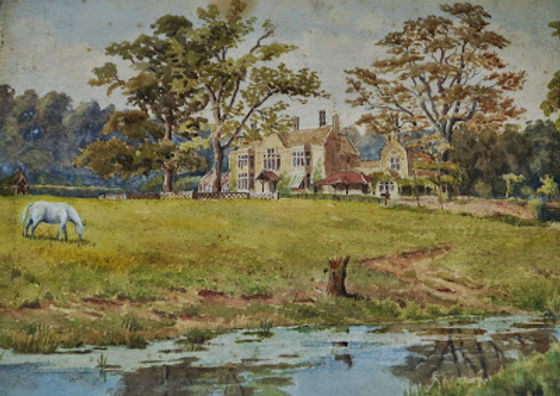
Shelford Hall from what is now the Little Shelford Rec. The former ice ponds can be seen in the foreground.
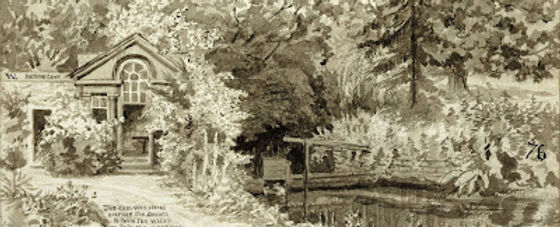
A drawing of the boathouse at Shelford Hall from A Record of Shelford Parva.
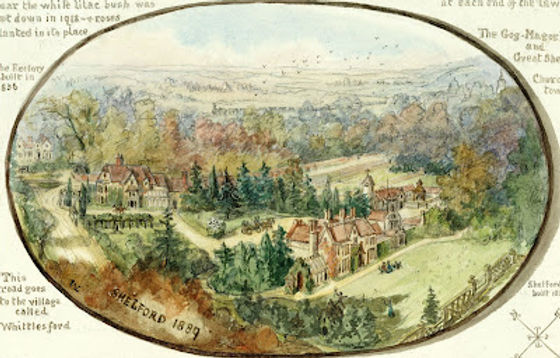
A painting of Little Shelford New Hall dated 1889 by Fanny Wale from A Record of Shelford Parva. The remains of the Old Hall which became the Lodge for the New Hall can be seen on the left of the painting. It could have been copied from the painting (below) which is still owned by the Wale family. The Shelford Old Hall, or the Old House, was built in 1640. It was altered in 1764 by Thomas Wale and then largely demolished in 1852.

A painting of Little Shelford old hall owned by the Wale family. The first Shelford Hall, or the Old House, was built in 1640. It was altered in 1764 by Thomas Wale. and then largely demolished in 1852.
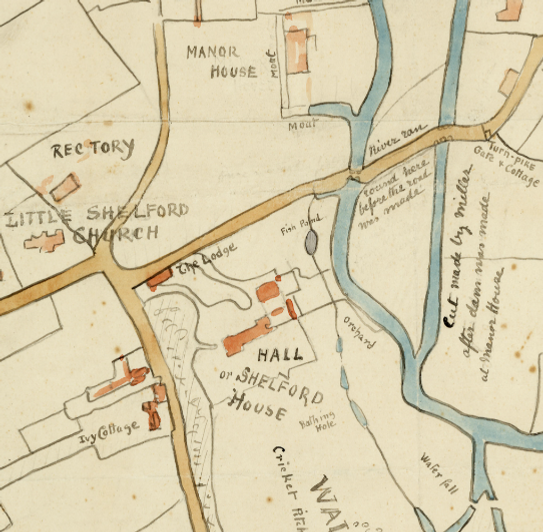
A map of the Shelford New Hall and the Wale estate from A Record of Shelford Parva by Fanny Wale. "This map is a tracing from one at King's College Cambridge
and was given to me (Fanny Wale) by Mr Corbett who passed away in 1926."
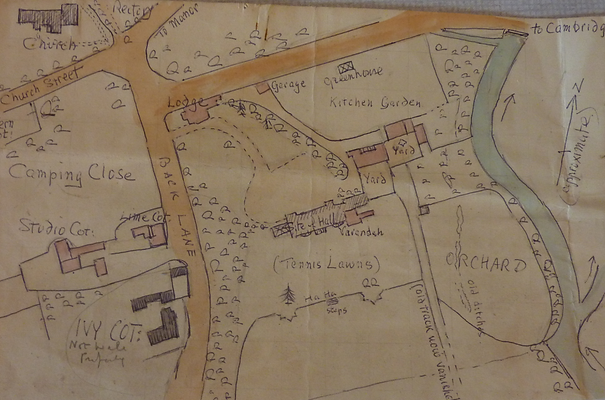
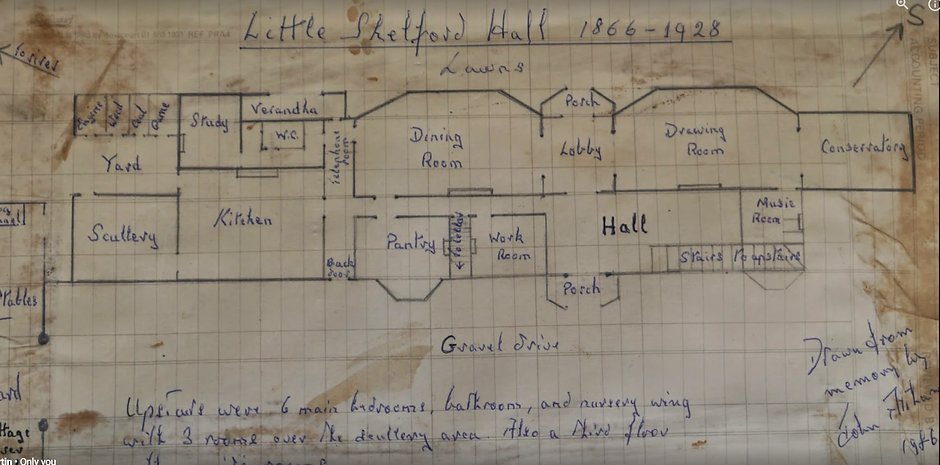
Plans of the New Hall drawn from memory by John Altham who lived there as a boy. Read some of his memories about growing up in the Hall.

Wale family picnic in Shelford Hall grounds around 1881

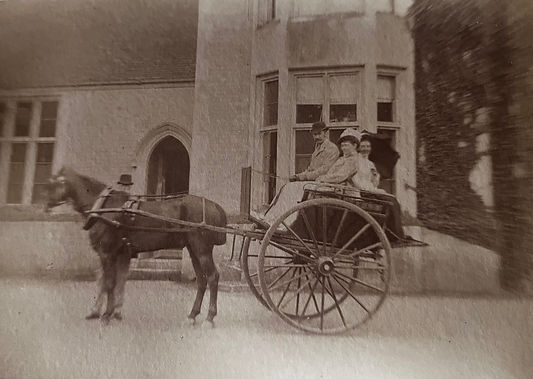
Horse and trap outside Shelford Hall around 1881 carrying members of the Wale family

Fishing party at Shelford Hall 1881

The grounds of Shelford Hall around1881
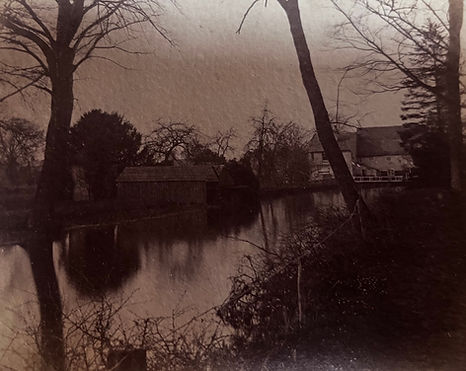
The River Cam in the grounds of Shelford Hall, with Shelford Mill in the background.


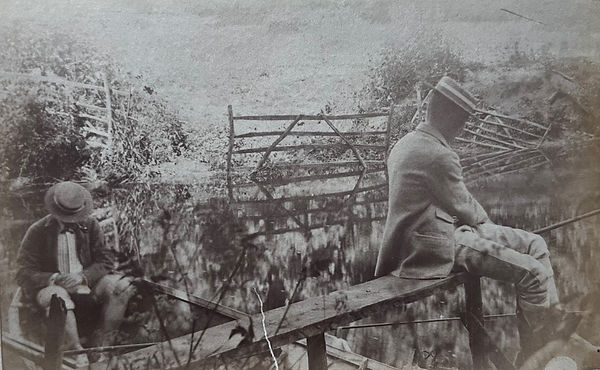

Part of the surviving stable block at Shelford Hall which has now been converted into a home

The old icehouse @ Michael Smith

The old icehouse @ Michael Smith

The old icehouse @ Michael Smith

The surviving ha-ha @ Michael Smith
Surviving steps to the old bowling green/sunken garden @ Michael Smith


Painting of Hall Cottage painted after the fire in 1929 @ Michael Smith

Shelford Hall bathing place 1885

Shelford Hall riverside 1889

Head gardener Albert Thoroghgood (right) in the kitchen garden of Shelford Hall @ Michael Smith

The Wale family in the river at Shelford Hall @ Michael Smith

Shelford Hall riverside including the Wale family boat

Punting on the river near Shelford Hall

Part of the surviving stable block at Shelford Hall which has now been converted into a home


John Altham playing tennis on the court at Shelford New Hall.
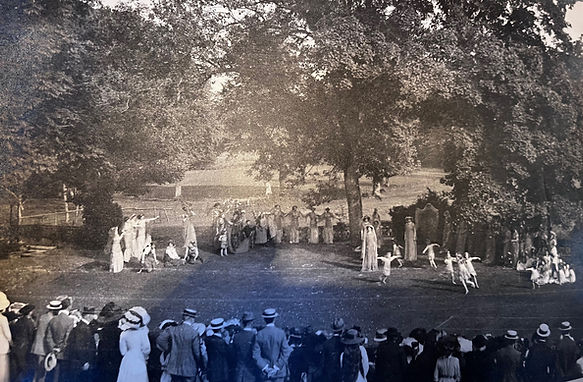
Shelford Hall summer event 1914
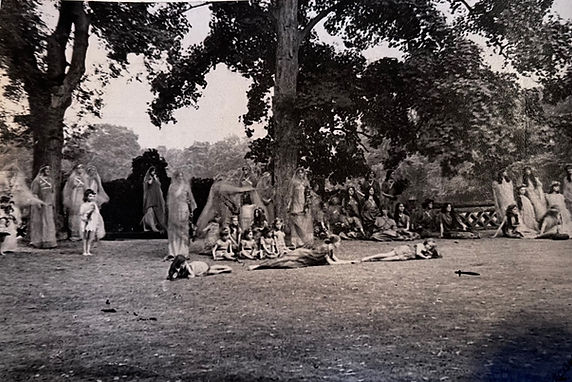
Shelford Hall summer event 1914

The fireplace from the Dining Room at Shelford Hall which had been moved there from the Old Hall.

Shelford Hall fire
Little Shelford New Hall was destroyed by fire on February 24 1929.
The fire, believed to have originated in the pantry, gutted the entire building. The roof caved in and there was little chance to retrieve any of the contents.
There were nine people in the Hall at the time of the fire according to press reports. None of them were believed to be injured. The Cambridge Chronicle suggests they were Captain and Mrs Gordon Dill and their children, Mme Carne, who was the Governess, the butler and the maid.
Mrs Eaden (seen in photo 5 below) was also said to be living there at the time of the blaze although the Hall was part-owned at the time by Fanny Wale.
Remains of the building can still be seen from Whittlesford Road and the Little Shelford Recreation Ground.
This is how the Cambridge News reported the fire:
"A disastrous fire occurred at the Hall, Little Shelford in the early hours of Sunday with the result that the building was almost completely gutted. It was discovered by Mme Carne, the governess who, with the butler and the maid, were immediately above the fire. Captain and Mrs Gordon Dill removed their children to safety in The Lodge. While waiting for the fire brigade which was delayed due to the thick fog, the occupants attempted to subdue the outbreak, then confined to the pantry, with buckets of water. But the heat melted a lead pipe and the cistern emptied so water had to be fetched from a cottage about 30 yards away. The building is 71 years old, being erected in the grounds of the Old Hall which was pulled down in 1858."
These are John Altham's recollections of the blaze in a note written in 1982 (he grew up in the Hall but was not living there at the time of the Fire).
"Some cousins borrowed the hall for the winter when we were living in my aunt's house in Cambridge.
"They had a butler who left sticks to dry in the pantry one night and in the middle of that foggy night, the house caught fire and the Cambridge fire engine could not find the house until it was fully alight.
"Then they had no water until they laid pipes to the river. Alas only a little furniture and some pictures were saved by Mr Thorogood (the Chauffeur and gardener) and many others who were alerted, and who worked all night among the smoke and flames. Nothing was saved from the nurseries, sadly for my sister and me.
"The house was mortgaged so could not be rebuilt but an addition was built onto the front of the Lodge; thus the Lodge became once again the family home, because it had been half pulled down when the hall was built."
Life at Shelford Hall
"I have been asked to write down some of my father’s memories of growing up at the Hall in Little Shelford, to coincide with the 90th anniversary of its destruction by fire in February, 1929.
My father, John Altham, was born in 1909 and lived first in Cowes, where his father was a naval officer. His beloved sister Psyche was born in 1912. Unfortunately their parents became estranged and with their mother, Fiorella, they came to live at the Lodge midway through the First World War. They were invited by Isa Eaden, John and Psyche’s great aunt, who lived at the Hall with her husband Jack Eaden, a solicitor and partner of Eaden Spearing and Raynes in Cambridge.
Even before they moved to the Hall, the grounds and garden delighted the children. “We had the free run of the lovely garden surrounding the Hall where Aunt Isa and Uncle Jack lived. The mysterious grandeur of the Hall with its servants, its houses, the old mulberry tree, strawberry beds, peaches on the wall, the apple loft, pigs in their pens, chickens running around the stable yard, the big dog kennel with Bess, the shooting black retriever, always so excited to be talked to, the orchard running down to the river - and THE RIVER - the greatest excitement of all!”
There were horses kept in the stables, hunters for Jack Eaden and others for the pony and trap (a duckboard). Harry Want was one of the grooms and became one of my father’s oldest friends. William (Billy) Wisbey was another groom and gardener and he and John would aim at the two bells on the roof of the Hall with their airguns - with only limited success! “
The kitchen garden was a thrill too. Walled in, it had everything, including two strange pits about four feet square and two feet deep, with wooden covers over them, as a spare water supply for hand watering cans. These were inhabited by enormous toads, quite frightening for children! The green houses, full of exotic plants for the house, were heated by coke boilers and enormous iron pipes running under the staging, and they smelled as only green houses fully furnished can smell - quite delicious.”
To come back to the river! John and Psyche were allowed to take the punt out on the river on their own, sometimes going out all day, going up past the Manor House into the open fields towards Hauxton, or up towards the Mill, where they would swim in the Weir. Swimming and diving in the Weir was considered safe as the water was clear - unlike the Perch Hole which was deep and murky. (Now marked “Deep water”.) They would fish in the river “which abounded with wild life, with birds, butterflies, rabbits, moorhens and very special - the kingfishers. (A word about the punt. It was made by the local builder, Mr Walker, father of the Walker Brothers who went on to build so much in Little Shelford.)
In 1923 Jack Eaden died and Aunt Isa invited John, Psyche and Fiorella to live with her in the Hall to keep her company.
When Jack died, Isa enjoyed a busy social life (he had been rather austere). There were tennis parties, an annual cricket match against the village XI, an annual pageant, where one year my father and his sister were dressed as miniature green flies! Psyche, a talented dancer, would dance for dinner guests on the lawn “in the lights of Uncle Barry Willis’s car!”
This idyllic life came to an end in 1929 when the Hall was tragically burnt down. Isa and the family were in Cambridge at the time, living in Brookside where they spent the winters - the Hall being too costly to keep warm. The Hall was rented to some cousins. Legend has it that some sticks which had been left to dry in front of a stove caught fire. Because of a thick fog the fire engines couldn’t arrive in time to save the house.
I believe that my father’s great affection for the village stemmed from the marvellous years spent first at the Lodge and then at the Hall. In his mémoires he writes more intimately and in more detail of his life there, but I hope that this account will offer a glimpse of what it was like for a small boy and his beloved sister to grow up in such a wonderful and privileged world - which he always appreciated as such, being endlessly thankful to Aunt Isa for all she gave him and his family."
Jane Lagesse
February 2019
John Altham also wrote some of his own memories of the Hall in 1982.
"The war (World War One) is now over and my uncle died, so we are now living at the Hall with my aunt. We have our own nursery down a long passage which frightens us in the dark, especially when the candle blows out.
"I have a big toy cupboard full of Meccano, trains, my butterfly boxes and books.
"We go to the river often where we have a large punt t the perch hole."
"Mr Albert Thorogood has also come back (from the War) and he is Chauffeur and gardener. Mr Wisbey is also gardener. Also in the stable yard are Mr Whitfield and Mr Harry Want who look after some hunters which belong to Mr and Mrs Pares Wilson who have come to live at the Manor House.
"In the house we have cook and Lena and Celia living in and more help for the visitors in the summer. When the grown ups go out we often play hide and seek with the maids in the house or the garden. The house is very long and has lots of hiding places. Lena is young and loves playing - - she giggles all the time. Celia is older and very stern. When there is a dinner party she comes in and runs the men out of the dining room to stop them drinking too much port".
........................................................
"Built in around 1866 by Gregory Wale who pulled down half the old Wale home leaving the remaining half as a lodge at the gate to the New Hall. The Hall was gutted by fire in 1928. Instead of rebuilding it, the Lodge was added to again to be the family home.
"Fiorella, Psyche and I lived in the Lodge from about 1916 but later lived in the Hall with our Great Aunt Isa Eden (nee Willis) until 1928. We all then lived in the enlarged lodge until 1939 when war broke out and the family moved to 12 Brookside, Cambridge.
The Lodge was sold after the war. This was drawn by Barty (S.G.R.) Willis from near the river. He built South Lodge
in the 1920s."
John Altham
Here is John Althams' account of the fire at the Hall in 1929.
Here is John Altham's account of living at the Hall.
Here is John Altham's account of the M11 coming to Little Shelford.
The Society wedding of Adelaide Wale that took place at Little Shelford New Hall in 1881.
Memories of the day have been found in some old diaries written by Mrs Isabella Martha Willis which are still held by members of the Wale family and transcribed by one of the family, Patricia Altham.
Introduction
The clergyman Sherlock Willis married Isabella Martha Wale, the eldest daughter of General Sir Charles Wale and Isabella Johnson, in 1834. Sherlock and Isabella had seven sons and one daughter. The sixth of these sons was Reginald Willis, born in Paris in 1848, and the daughter was Isabella Martha Willis, always known as Isa. Isa was also born in Paris, in 1847. Mrs Isabella Martha Willis was an assiduous writer of her diaries, and we have many of these journals from 1830 to 1890? They are quite hard to read, but I particularly liked the diary for June 1881, for its description of The Wedding between her son Reginald and his cousin Adelaide Wale.
Who was Adelaide Wale? She was usually known as Aida, and was one of the two daughters of Captain Frederick Wale. Alas, Captain Frederick was killed in the siege of Lucknow in 1857, but his two little daughters, Aida and Minna, escaped by being hidden in the back of a bullock cart, presumably with their mother, who was also called Adelaide.
Frederick Wale and Mrs Isabella Willis were two of the children of General Sir Charles Wale, but by different mothers. ( Sir Charles Wale married three times, and fathered twelve children.) The year 1881 was an exciting one for Mrs Isabella Willis, as the weddings of both Isa and Reginald took place then. In June 1881 Reginald Willis married Adelaide Wale and in due course their daughter Cecil Willis (always known as Fiorella) married Captain Edward Altham RN, and they had children John and Psyche Altham. John and Psyche spent much of their childhood at The Hall, Little Shelford, by invitation of their great aunt Isa, who had married Jack Eaden but had no children. Fortunately for us today, my father in law John kept all these diaries of the mother of his great aunt Isa, who had played such an important role in his childhood.
By the time of the wedding, Isabella Willis was a widow aged 72, living in London at 5, Foulis Terrace. In coming to Little Shelford for the wedding, she was returning to the scene of her childhood, where several members of her family still lived, including her half brother Robert Wale who lived at the Hall. (What is still a mystery is the name of her 7th son, and why he was not present at the wedding....perhaps he had died by 1881? Adelaide’s sister Minna married Major Marshall soon after this wedding.
.........................
6 June, Monday.
Left home at 5m to 4. No crowd this Whit Monday — found all very merry at Shelford, except poor Mother Adelaide. I was to be put up at Robert’s.......
8 June, Wednesday. Fine morning but very cold. Got Aida and Reginald to my room and gave them affectionate allocution of my deep and fervent Blessing —they both seemed touched and were most loving, affectionate and reverential. Wedding presents brought over from Long Melford.....
9 June, Wedding
“150 people — and Dance in the Evening in spite of the cold sitting out at night until 4 in the morning!!” I find only this in my Diary — but this always so, when one feels most,one details least— but now that more than a Month has past— I may well write down a few particulars— which at this time I did for Horace and Emily at Montreux I am — or at Chateau d’Oex where they see my letters.
The day was tolerably fine — smattering of rain now and then— also sun breaking out between and as we went to and fro’ Church it shone out. A number of course came from Cambridge and the Prest party were in the house, Isa also— and Mr Law— and others helped to give bedrooms.
We breakfasted in the large tent which had been put up at the end of the Conservatory— and all except Adelaide and her sister and I think Reginald were at it — but it was a dropping in of course and quite informal.
Some of the Hyde Parkers, and Martyns came over from Long Melford. At 11.15 we began to go over to the church, which Isa and the girls had well decorated with flowers about the chancel and Communion Table. Mary sat at and played the organ. The Uncle Henry J. Wale and Mr Martin (in gloves)! officiated. Bride given away by Robert— we the near relations stood nearest and the Eaden children.
Aida looked a sweet modest pretty little bride— and my Reginald as fine a specimen of a young and happy bridegroom as one would wish to see— his brothers Armine, Sherlock, Harry, Cecil were, with himself 5 of my sons present! only two missing of the Band of 7 brothers—one is not! — the other Horace, with his wife and children in Switzerland (?).
Isa looked gay in a light Pomona green silk dress with white hat — the Bride in an Ivory brocade ..... a Net veil and orange blossoms prettily fastened on by Miss Hyde Parker. Her bridesmaids were 5. 1, Fanny Wale, 2, Freda Wale, 3, Annie Williamson, 4, Maud Wale, 5, Blanche Wale. bridesmaids’ dresses were Ivory White material? embroidered by themselves in gold colour and green, straw hats trimmed with white lace and a few flowers— they were pretty enough being uniform, but scarcely worth the trouble they had given. Reginald gave each bridesmaid a golden fibula brought from Rome! He wore the customary frock coat, greyish trousers and a sort of ivory white and gold cravat—which sounds bad but looked well as is the fashion! My costume was the inevitable black (but new) silk dress — a white crepe de chine Mantelet and an Ivory white bonnet with lace trimmings and deep red roses without leaves— Parasol Ivory satin and lace guipure. The church was very crowded with villagers, and the church gate. Aida had herself chosen a nice hymn which was sung in the church — which I give. One thing to be remarked was the outspoken tone with which Reginald pronounced his “I will”!
Our soul shall magnify the Lord
In Him our Spirit shall rejoice
Assembled here with one accord
We praise Him with our heart and voice.
May we the Christian law fulfil
And bear each other’s burden here
And thus unite to do Thy Will
In perfect love and Holy Fear.
Grant that our union here begun
May ever firm and lasting be
Around Thy throne May we be one,
One with each other, one with Thee.
Amen
A very nice breakfast was ready in the Dining room. Tables of all sizes, and none very large, were placed for parties to make themselves up. It was very pretty, very well done, and very abundant. Robert and Mr Martyn would NOT allow the old custom of health to Bride and Bridegroom to be foregone— so Reginald was rather taken aback for his speech which was a very short one — and Mr Martyn much wanted more healths — but was not allowed to propose them. By the way, we all walked back from Church, it was so fine and pretty to see.
Then came the viewing of the presents, and the Bride’s dressing for their journey, and then they were off in Robert’s carriage with the pair of Isabelle’s to Cambridge to meet the train for Lincoln — subsequently to York, and in a few days to Norway! Of course Major Marshall had a place alongside of Minna and both were very happy. after the pair were gone, Great rush to throw ??? ?? at both ?? made by the whole flight of young ones. We elders went upstairs and the others set to changing their clothes.and went to Lawn ?? The Military Band also was on the Lawn, and the dance and under the trees the ? danced — and it was very gay—till at 9 or so all was lit up and we all came down, arrayed for the Ball, which lasted
till Daylight was fairly set in— a good dancing band they had and they made them play!! I went to bed at 4 — they were still dancing!
May God have blessed them who left their parents this day!
———————————-
10 June. All late of course.
From the Victorian County History of Cambridgeshire
A considerable estate was built up in Little Shelford from the early 18th century by the Wale family.
Gregory Wale (d. 1739) bought from Gilbert Wigmore a house and land there which he left to his son Hitch Wale (d. 1749), with remainder to his other son Thomas. n 1765 Thomas leased the house from Hitch's widow who had a life interest. Thomas, a Riga merchant, bought other land in the parish, and on his death in 1796 at the age of 95 was succeeded by his son Charles, later General Sir Charles Wale, who after inclosure in 1815 held c. 380 a. in Little Shelford. Thomas had left his estate to his daughter, Margaretta Philippina, who after 1815 held c. 140 a. ) Her estate, known as King's farm, passed on her death in 1841 through her niece Isabella Willis to Robert Gregory Wale, and then to Isabella's son-in-law J. F. Eaden. (fn. 80) Sir Charles Wale's eldest surviving son Alexander Malcolm succeeded his father in 1845, and in 1850 sold his Little Shelford estate to his brother Robert Gregory Wale (d. 1892). The latter's son R. F. Wale died in 1893 and was succeeded by his five sisters whose estates eventually descended to Miss Norah Cecil Wale Powell (fl. 1962). R. G. Wale's brother Charles Brent Wale (d. 1864) also held an estate in Little Shelford, known as Saintfoins. It passed in turn to his son Frederick and grandson C. G. B. Wale (fl. 1937).
The Wale family's house, known as Shelford House or Hall or the Old House, south-east of the church, was of 17th-century origin. It was altered in 1764 by Thomas Wale and largely demolished c. 1852. The north wing, which has walls of 18th century brick but has been much altered, was left as an entrance lodge to a new house built in a Gothic style for R. G. Wale by W. J. Donthorn. Much of that building was burnt down in 1928 (sic). The north wing and parts of the mid 19th-century stabling, converted into private houses, survived in 1980.
Between 1775 and 1845 a family mausoleum, designed by William Wilkins, stood west of the house in Camping Close. The house stood in a small park adjoining the Whittlesford road.
David Martin's talk about Little Shelford's two halls at the Little Shelford Local History Society
Whatever happened to Little Shelford’s two halls? I’m David Martin, a writer and storyteller. I am about to share some historical photos and drawings, and some memorable stories about our halls which were at the heart of village life for 400 years.
Along the way, you’ll hear about how the Australian gold rush affected one hall, what links escaping a famous siege hidden under a blanket in a horse and cart and Shelford Hall, and how a dramatic fire burnt down our version of Downton Abbey.
This is Shelford Hall. There are almost 70 photos and paintings of the two halls on the village’s history website.
This is one of them, of Little Shelford New Hall. What happened to it is not exactly a mystery. But many people in the village don’t realise that
Little Shelford has boasted two major halls over the last four centuries.
Shelford Hall was the family seat of the Wale family who were the principal landowners in Little Shelford for 300 years.
Many of you will have walked or driven past the remains of the first hall on your way here tonight.
This is what remains today of our hall - gate posts and part of the stable block which are now two homes. By the end of this evening, you’ll never walk past these gates again without thinking about the hall that dominated life in Little Shelford.
Let’s take a step back in time to 1880.
I present to you, Little Shelford Old Hall (on the left)
This drawing is a tracing from one at King's College Cambridge.
You can see Whittlesford Road, what is now the Rec and even the stagecoach that used to stop outside Shelford Hall.
Recognise this? It’s the Lodge – the yellow house at the junction of Bridge Lane and Whittlesford Road, down that end of Church Street.
It’s also the partial remains of Little Shelford Old Hall. (Pause) The Lodge was the north wing of the original 17th century Old Hall. With respect to the current owners, it doesn’t look much like a hall now, does it? Why might that be?
Let’s go on a historical journey together.
This what the Old Hall would have looked like in its heyday if you were standing in Camping Close off Whittlesford Road. Isn’t it grand? You can see the elements that go to make up the current Lodge on the left of this drawing.
Along with the Manor House, it was one of the two main houses in the village for 200 years.
This is the view if you walked down to the end of Church Street and right turned into Whittlesford Road, with Camping Close behind you.
The Old Hall was built in around 1660 by Thomas Wale. The oldest portion of the House, the South Front, with its small, recessed windows and large chimney, was 200 years older ie from the fifteenth Century. The hall also boasted a 10 acre park along the river, much of which is now the village rec and the site of Courtyards.
Thomas Wale, retiring from his ship building at Riga, preferred Shelford to Harston Hall as a residence, and so made an arrangement to rent the House for the yearly sum of £30 and took up residence in 1765.
This is a drawing from the Wale family archive being seen in public for the first time.
Words from the back of the drawing tell us that this is the chimney piece of the Old Hall’s study.
The oak overmantle was later put into the dining room of the New Hall.
The fireplace was later moved to Ivy Cottage.
There is a model of the old hall building which is now in the possession of the Museum of Cambridge though it is not currently on display. (You can ask to see it by the way).
Here is a lovely description of the Old Hall by Wale family historian, Graham Chinner:
“With its six staircases, beamed and oak-panelled rooms and enormous Elizabethan fireplaces, it seems to have been a commodious and comfortable house, lived in and loved by generations of the Wale family. It was however not grand, and was in a poor state of repair when it was partially demolished in the 1850s.”
These two photos show you the corner of Whittlesford Road and Bridge Lane and what the hall would have looked like on the right compared to the current Lodge on the left.
This is how the Old Hall would have looked like as you walked along Bridge Lane
This photo of the model made by Colonel Wale show the U-shaped ranges enclosing an open courtyard. Again, Bridge Lane is on the left and Whittlesford Road runs along the bottom of the photo. It was a fascinating old building.
The hall wasn’t always a home for the Wale family. In the early 1800’s, the Rev. Mr Preston ran a school for up to 12 pupils in Shelford Hall.
One of its pupils went on to be rather famous. That pupil was Thomas Babington Macaulay, a historian and Whig politician, who served in Government as the Secretary at War between 1839 and 1841, and as the Paymaster General between 1846 and 1848.
He was at the school from 1812, he wrote extensively. His biography includes many letters written when he was at the School in Little Shelford including this interesting anecdote.
When Macaulay, feeling homesick, wrote home unfavourably about the people of Shelford, his father urged the 8 year old to set about reforming them. (That worked well then).
This is a lovely photo from the Wale family archive and its historically important.
In the middle of the 19th century, the old Hall was partially demolished, because it was regarded as being dilapidated. This left the remaining half as a lodge to be the gatehouse to the New Hall. This photo is significant as it shows the Lodge between 1860 and 1908 shortly after it has been shrunk down but before it was extended again.
BTW That’s blacksmith Charles Elbourn in the foreground.
Here’s the Lodge again, but there’s a difference. It has an extension on the side to help the building accommodate some of the Wale family after the fire in 1929. That extension is still in place today.
As an aside, the Lodge was also used as an officer’s mess and offices in WW2 according to John Altham.
Right now lets move onto the New Hall.
Talk through location from map from about 1920.
Mention river cut on right.
So here’s what the Wale estate would have looked like if you had a drone in the 19th century. Wasn’t it lovely? You can see the New Hall on the right, and the Lodge – the rump of the Old Hall – on the left.
The new Gothic style house, known at the time as the New Hall, or Shelford House, was built around 100 metres north of the current Wale Recreation Ground in about 1852 by Robert Gregory Wale.
Col. Wale built the hall with his wife's money when he married Fanny Anna West, because her uncle thought the Old House was too dilapidated for her to live in.
Village historian Fanny Wale was the eldest of Colonel Robert Gregory Wale’s seven children. Its strange to think that when she was born in 1851, the paint was scarcely dry in the spanking new Shelford Hall.
PAUSE/ break
This is the hall in all its finery.. Wasn’t it grand? You can see the tennis court in the foreground.
The New Hall had six bedrooms. The servants' quarters were on the third floor.
One member of staff at the hall caught the eye of family historian Fanny Wale as he did something to help the whole village every single day.
“Charles Cooper, who was born deaf and dumb, but learned to talk and understand other people, worked under his father who was head gardener at Old Shelford Hall, and subsequently was house boy in the new house.
“He called himself “Chubber”, he helped to clean silver and copper and rang the house bells very punctually at 8 a.m. and 1 p.m, they were then useful to the whole village, now they are not much used and people set their clocks by the railway trains,” wrote Fanny Wale.
“Another of Charlie Cooper’s duties was to pump water into the upstairs cistern which supplied the big bath and the kitchen boiler. Shelford Hall was let to some friends who brought their own servants, but Chubber refused to leave so he had to be hired with the house, and the tenants found him very useful and amusing. He kept a watch over everything and scolded anyone he thought was careless or mischievous.”
This is how the Hall would have looked from Bridge Lane.
It was a beautiful building. But it was almost as if it was fated from the start. In reality, the Wale family only enjoyed 30 years of good living at the hall.
To quote village historian, Graham Chinner, Col Wale could hardly have chosen a less auspicious time to indulge in a palace.” The Corn Laws were repealed in 1845 meaning untaxed grain from America flooded the market and made the Shelford Farms owned by Col Wale difficult to rent. Col Wale finished up moving out of the Hall to Hall farmhouse around 1885.
This is where the hall history takes a fascinating twist.
From then on, Shelford Hall seems to have been let to tenants, initially to the Hallett family who had struck it rich discovering gold in Australia until they lost most of their fortune in the Australian bank failures.
Extended members of the Wale family were later to become tenants of the hall.
This is my favourite picture of the hall, again from the Wale family archive.
This is a fascinating painting in so many ways, and captures the hall at the height of its glory.
Bride Adelaide Wale had a colourful life. Adelaide, or Aida as she was known, was one of the two daughters of Captain Frederick Wale. Captain Wale was killed in the siege of Lucknow in India in 1857. But children Aida and her sister Minna, escaped with their lives by being hidden under blankets in the back of a bullock cart.
This painting shows the society wedding of Adelaide Wale to her cousin Reginald at Shelford Hall in 1881. His mother’s diary revealed that the wedding celebrations went on until after 4am the next morning.
We know most about life at Shelford New Hall from the writings of John Altham, a member of the Wale family. John’s children, Jane Lagesse and Jimmy Altham are with us this evening.
This is the layout of the hall, according to John who sketched this from memory in 1986.
Describe the lay out of the hall. Telephone room. Music room. Description on the bottom of the picture.
In the latter part of the 19th century, the hall seems to have been mothballed. Kellys Directory of Cambridgeshire for 1900 does not record it as occupied.
John Altham came to live at the Lodge midway through the First World War with his sister and his mother. They also spent a lot of time at the New Hall, which was now rented by relative, Isabella, and her husband Jack Eaden.
“We have our own nursery down a long passage which frightens us in the dark, especially when the candle blows out,” John Altham wrote in his diary.
"I have a big toy cupboard full of Meccano, trains, my butterfly boxes and books.
"We go to the river often where we have a large punt at the perch hole."
I believe this is tenant Jack Eaden in the hall gardens.
John Altham’s diary continues: “We had the free run of the lovely garden surrounding the Hall where Aunt Isa and Uncle Jack lived. The mysterious grandeur of the Hall with its servants, its houses, the old mulberry tree, strawberry beds, peaches on the wall, the apple loft, pigs in their pens, chickens running around the stable yard, the big dog kennel with Bess, the shooting black retriever, always so excited to be talked to, the orchard running down to the river - and THE RIVER - the greatest excitement of all!”
This shows a Wale family picnic in around 1880. John didn’t write about that but he had more to say about the gardens.
“The kitchen garden was a thrill too. Walled in, it had everything, including two strange pits about four feet square and two feet deep, with wooden covers over them, as a spare water supply for hand watering cans. These were inhabited by enormous toads, quite frightening for children! The green houses, full of exotic plants for the house, were heated by coke boilers and enormous iron pipes running under the staging, and they smelled as only green houses fully furnished can smell - quite delicious.
The next section of John Altham’s diary gives you an idea of staff who ran the Hall. "Mr Albert Thorogood has come back (from the War) and he is Chauffeur and gardener. Mr Wisbey is also gardener. Also in the stable yard are Mr Whitfield and Mr Harry Want who look after some hunters which belong to Mr and Mrs Pares Wilson who have come to live at the Manor House.
"In the house we have cook and Lena and Celia living in and more help for the visitors in the summer.
“When the grown ups go out, we often play hide and seek with the maids in the house or the garden. The house is very long and has lots of hiding places.
“There were tennis parties, an annual cricket match against the village XI, an annual pageant, where one year my father and his sister were dressed as miniature green flies! Psyche, a talented dancer, would dance for dinner guests on the lawn “in the lights of Uncle Barry Willis’s car!”
You may have heard a moment or two ago I mentioned Chauffeur Mr Albert Thorogood.
He was clearly loved by the Wale family to the point where he inherited the Wale family Rolls Royce.
Legend has it that Albert didn’t have much use for the car. So, he finished up using it to pull the plough on his garden.
Albert also used a motor cycle engine to create what was the first mechanised lawn mower in Little Shelford – he was obviously an ingenious chap.
This idyllic life came to an end in 1929 when the Hall was tragically burnt down.
Little Shelford New Hall was destroyed by fire on February 24 1929, 95 years ago this Saturday.
The Cambridge Chronicle report stated: "A disastrous fire occurred at the Hall, Little Shelford in the early hours of Sunday with the result that the building was almost completely gutted. It was discovered by Mme Carne, the governess who, with the butler and the maid, were immediately above the fire. Captain and Mrs Gordon Dill removed their children to safety in The Lodge. While waiting for the fire brigade which was delayed due to the thick fog, the occupants attempted to subdue the outbreak, then confined to the pantry, with buckets of water. But the heat melted a lead pipe and the cistern emptied so water had to be fetched from a cottage about 30 yards away."
The fire is believed to have originated in the pantry, and gutted the entire building. The roof caved in and there was little chance to retrieve any of the contents.
Philippa Pearce, the author of Tom’s Midnight Garden, who was the daughter of the miller in Kings Mill Lane, recalled as a small girl being held up to a window to see the flames as the fire took hold.
The hall was almost completely destroyed. This was because the Fire Brigade couldn’t find the hall because of the heavy fog that night.
Here is John Altham again: “Some of the family were in Cambridge at the time, where they spent the winters - the Hall being too costly to keep warm. The Hall was rented to some cousins. Legend has it that some sticks which had been left to dry in front of a stove caught fire.”
The owner at the time of the fire was Fanny Lucretia Wale, the compiler of the book “A Record of Shelford Parva”. She had not lived in the Hall for a quarter of a century, having let it to relatives for much of that time.
Tenant Isa Eaden can be seen on the right of the photo searching through the remains of the fire.
John Altham wrote: "The house was mortgaged so could not be rebuilt but an addition was built onto the front of the Lodge; thus the Lodge became once again the family home.”
“We all then lived in the enlarged lodge until 1939 when war broke out and the family moved to Cambridge.”
The Lodge was sold by the Wale family after WW2.
Thank you for indulging me.
And a special thank you to Jane Lagesse and Jenny Chinner for being so generous sharing the information they have amassed about the halls.
So, that is the story of our two halls which were at the heart of Little Shelford’s history for 300 years.
One was partially demolished. One was gutted by fire.
All the photos you have seen tonight and the words of John Altham can all be seen on the village’s history website at www.littleshelfordhistory.com
Posted Nov 17 2025
Other sections on the Little Shelford history website
www.littleshelfordhistory.com/fanny-wale-book
www.littleshelfordhistory.com/photos
www.littleshelfordhistory.com/buildings
www.littleshelfordhistory.com/people
www.littleshelfordhistory.com/history-1
www.littleshelfordhistory.com/archaeology
www.littleshelfordhistory.com/world-war-one
www.littleshelfordhistory.com/maps
www.littleshelfordhistory.com/censuses
www.littleshelfordhistory.com/family-trees
www.littleshelfordhistory.com/graveyard-inscriptions
www.littleshelfordhistory.com/memories
www.littleshelfordhistory.com/history-stories
www.littleshelfordhistory.com/historical-memories
www.littleshelfordhistory.com/village-sign
www.littleshelfordhistory.com/books
www.littleshelfordhistory.com/heritage-trail
www.littleshelfordhistory.com/links
www.littleshelfordhistory.com/about-1
www.littleshelfordhistory.com/history-society
www.littleshelfordhistory.com/contact
Other sister community websites

